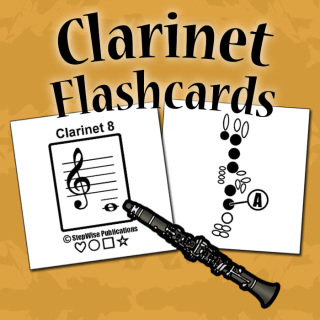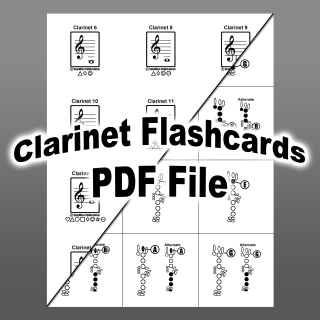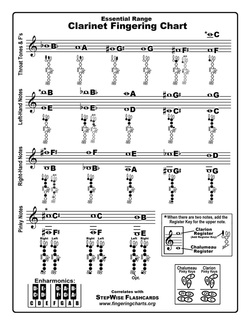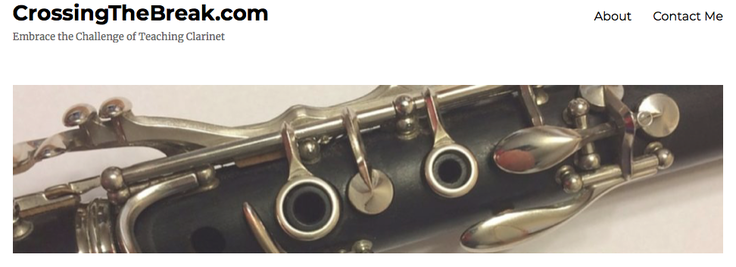Learn to Play the Clarinet - Fingering Chart & Flashcards
Download the StepWise Clarinet Fingering Chart
|
The fingering charts in most band method books do not show how the chalumeau and clarion registers are related, and are spread across 2 pages. This free chart shows young musicians how the notes on the clarinet are organized by finger (from top to bottom) and register, making it much easier to memorize!
This chart also has a handy "Pinky Key" chart. As a bonus, everything fits easily on one page! This allows students in your band to keep this chart on their music stand and use it frequently as a quick reference. I like to print these out for my whole band on cardstock and pass them out in the first week of school, along with the fingering flashcards. It is a powerful combination! Download now by right-clicking link below:
| |||
Clarinet Fingering FlashcardsClarinet students often learn to play C-D-E-F-G very well, but struggle with other notes, including common accidentals, notes in the upper register, and notes that use the left or right pinky keys.
Wouldn't it be great if all of your clarinetists knew the clarion register as well as the chalumeau? Wouldn't it be great if they all know which pinky keys to use for different situations? These flashcards will help both beginning and more advanced players to learn, memorize, and master every note, note name, and fingering on the clarinet. |
|
Clarinet Fingering Issues and Concepts
The clarinet has many things in common with other reed instruments, such as having a left-hand thumb key to pop the fingered note up to a higher register and having several pinky keys for each hand. It also uses the Boehm fingering system, making the basic finger pattern almost identical to the flute and saxophone. However, there are three unique features of the modern clarinet, including the following:
1-The clarinet thumb key does not cause it to jump up an octave like the saxophone, flute, or oboe, but instead the cylindrical bore of the clarinet skips a partial and jumps to an Octave+Fifth. Therefore, the middle- C on clarinet will become a high-G (on top of the staff) when you add the REGISTER KEY. For details about why this happens, click here (wikipedia) or here (Michigan Tech).
2-There are specific names for the three primary ranges on a clarinet - the Chalumeau Register is the lowest, the Clarion Register is played when pressing the register key, and the Altissimo Register uses unusual fingering combinations which mostly include pressing the register key but opening the left-hand first finger hole. For a list of altissimo fingerings, click here.
3-The clarinet is the only instrument which has complementary/matching pinky keys for both hands. Specifically, three of the pinky keys have a matching key which serves the same function for the other hand. This allows clarinet players to alternate right/left hand pinky keys in order to perform smooth slurs between any combination of notes. For a good article by Bret Pimentel on how to navigate the choice of pinky keys click here.
For more details about the clarinet, including its history and terminology, click here to see the wikipedia article.
1-The clarinet thumb key does not cause it to jump up an octave like the saxophone, flute, or oboe, but instead the cylindrical bore of the clarinet skips a partial and jumps to an Octave+Fifth. Therefore, the middle- C on clarinet will become a high-G (on top of the staff) when you add the REGISTER KEY. For details about why this happens, click here (wikipedia) or here (Michigan Tech).
2-There are specific names for the three primary ranges on a clarinet - the Chalumeau Register is the lowest, the Clarion Register is played when pressing the register key, and the Altissimo Register uses unusual fingering combinations which mostly include pressing the register key but opening the left-hand first finger hole. For a list of altissimo fingerings, click here.
3-The clarinet is the only instrument which has complementary/matching pinky keys for both hands. Specifically, three of the pinky keys have a matching key which serves the same function for the other hand. This allows clarinet players to alternate right/left hand pinky keys in order to perform smooth slurs between any combination of notes. For a good article by Bret Pimentel on how to navigate the choice of pinky keys click here.
For more details about the clarinet, including its history and terminology, click here to see the wikipedia article.
For music educators who teach beginners, this website provides amazing ideas and resources for dealing with beginning clarinet pedagogy: http://crossingthebreak.com/





